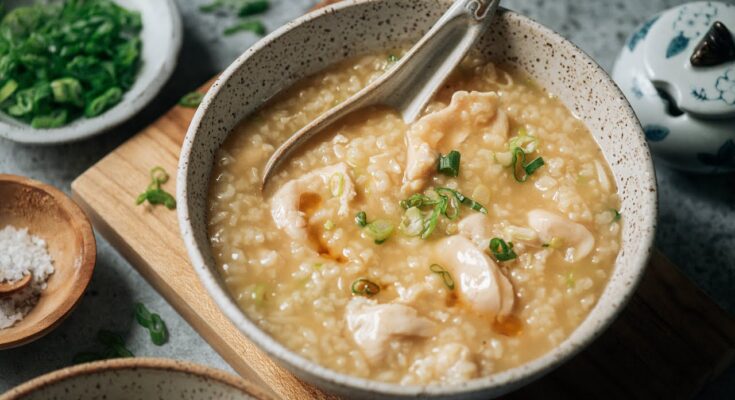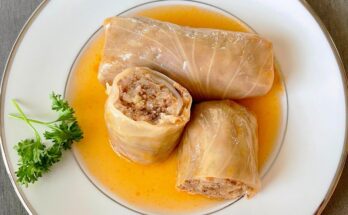Jook Recipe: Jook, also known as congee, is a warm and comforting rice porridge enjoyed across Asia. It has a rich history, originating as a simple meal for sustenance, but it has evolved into a beloved dish served for breakfast, as a remedy for sickness, or even as a hearty dinner.
Whether you’re a seasoned cook or a beginner, this step-by-step guide will help you make Jook that’s both delicious and customizable to your taste.
Ingredients for Making Jook
To prepare a classic pot of Jook, you’ll need:
Basic Ingredients:
- 1 cup of uncooked white rice (jasmine or short-grain is preferred).
- 8 cups of water or chicken stock.
- Salt to taste.
Optional Ingredients for Flavor:
- Cooked chicken, pork, or seafood.
- Ginger slices.
- Garlic cloves.
- Scallions, cilantro, or fried shallots for garnish.
Tips for Choosing Ingredients:
- Fresh stock makes a huge difference in flavor.
- Choose aromatic garnishes like ginger or green onions for added depth.
Types of Jook
Jook is highly versatile and can be tailored to your preferences:
- Chicken Jook: Add shredded chicken breast for a hearty version.
- Pork Jook: Use ground pork or slices of pork belly for rich flavor.
- Vegetarian Jook: Add mushrooms, tofu, and vegetable broth.
- Seafood Jook: Stir in shrimp, fish, or scallops for a briny twist.
Tools Needed to Make Jook
Here’s what you’ll need:
- A large pot or Dutch oven.
- A wooden spoon for stirring.
- Measuring cups and spoons.
- A ladle for serving.
Alternatives: Don’t have a heavy pot? A rice cooker or Instant Pot can work just as well!
How to Prepare Ingredients
Before you start cooking, proper preparation is key:
- Washing the Rice: Rinse the rice under cold water until the water runs clear to remove excess starch.
- Pre-Cooking Proteins: If using meat, cook it beforehand for easy shredding or slicing. For seafood, lightly season and cook it separately to prevent overcooking.
- Chopping Vegetables: Finely chop ginger, garlic, and garnishes like scallions for the perfect topping.
Cooking Jook: Step-by-Step Process
- Prepare the Rice Base: Add 1 cup of rinsed rice and 8 cups of water or stock into your pot. Bring to a boil.
- Simmer Gently: Once boiling, lower the heat to a gentle simmer and stir occasionally to prevent sticking.
- Cook Until Thickened: Let it cook for 45-60 minutes, stirring every 10 minutes to achieve a creamy consistency.
- Incorporate Proteins: Add shredded chicken, ground pork, or seafood during the last 15 minutes of cooking.
- Adjust Texture and Seasoning: Add more water or stock for a thinner porridge. Season with salt and pepper to taste.
Tips for Perfect Jook
Creating the perfect Jook requires attention to detail. Here are some tips to get it just right:
- Consistency Matters: Jook can range from thick and creamy to thin and soupy. Adjust the water-to-rice ratio depending on your preference. Start with 8 cups of liquid to 1 cup of rice, but feel free to add more as it cooks if you prefer a thinner texture.
- Stir Frequently: Stirring prevents the rice from sticking to the bottom of the pot and ensures an even texture.
- Balance the Flavors: Use flavorful stocks, like chicken or vegetable, instead of plain water for depth. A splash of soy sauce or sesame oil at the end can enhance the taste.
- Don’t Rush: Slow cooking over low heat is key to developing the signature creamy texture.
- Taste Before Serving: Always taste your Jook at the end to adjust the seasoning, as flavors can mellow during cooking.
Serving Suggestions
Jook is a blank canvas that shines when paired with the right accompaniments:
- Popular Garnishes:
- Chopped scallions
- Julienned ginger
- Fried shallots
- Soft-boiled eggs
- Pickled vegetables
- Side Dishes:
- Chinese fried dough sticks (you tiao)
- Kimchi for a spicy kick
- Steamed or pickled greens
- Presentation Tips:
Serve Jook in deep bowls, and drizzle with sesame oil or soy sauce for added aroma and a polished look. A sprinkling of fresh herbs or crunchy toppings adds visual appeal and texture.
Health Benefits of Jook
Jook isn’t just comfort food; it’s also packed with health benefits:
- Gentle on Digestion: The soft, easily digestible consistency makes Jook ideal for people recovering from illness or dealing with digestive issues.
- Nutritional Value:
- Rich in carbohydrates for energy.
- Customizable with proteins and vegetables for balanced meals.
- Hydration and Warmth: The liquid base helps with hydration, while the warm dish is soothing in cold weather or when feeling under the weather.
- Diet-Friendly: Jook can be tailored to fit various dietary needs, including gluten-free and vegan diets.
Regional Variations of Jook
Jook is enjoyed in many countries, each with unique twists:
- Chinese Congee: Often flavored with ginger, garlic, and soy sauce, it’s typically paired with you tiao and salted duck eggs.
- Korean Juk: Includes variations like abalone porridge (jeonbokjuk) or pumpkin porridge (hobakjuk), emphasizing seasonal ingredients.
- Filipino Lugaw: Often garnished with fried garlic, hard-boiled eggs, and calamansi for a zesty finish.
- Japanese Okayu: Simpler in flavor, often served plain or with umeboshi (pickled plum) for a light, refreshing taste.
Storing and Reheating Jook
Jook keeps well, making it a convenient meal option:
- Refrigeration: Store leftovers in an airtight container for up to 3 days.
- Reheating: Reheat on the stovetop over low heat, adding water or stock to restore the creamy consistency.
- Freezing: Portion the Jook into freezer-safe containers. When ready to eat, defrost in the refrigerator and reheat as usual.
Creative Twists on Traditional Jook
Modern adaptations of Jook bring exciting flavors to the table:
- Fusion Recipes: Add a dash of coconut milk and lemongrass for a Thai-inspired variation.
- Spicy Additions: Stir in chili oil, sriracha, or crushed red pepper for a spicy kick.
- Sweet Versions: Use milk or coconut milk, sugar, and toppings like fresh fruit, nuts, or honey for a dessert-style Jook.
Common Mistakes to Avoid
Even with its simplicity, Jook can go wrong. Here’s how to avoid pitfalls:
- Overcooking: Avoid cooking the rice to the point where it disintegrates completely. Aim for a creamy texture with a bit of rice grain structure.
- Using the Wrong Rice: Stick to short-grain or medium-grain rice, as they release starch for a creamy consistency. Long-grain rice tends to stay too separate.
- Under-Seasoning: Taste as you go! Adding salt, soy sauce, or fish sauce enhances the flavor significantly.
FAQs about Jook Recipe
What is Jook?
Jook, also known as congee, is a type of rice porridge that’s popular in various Asian cuisines. It’s made by slow-cooking rice in a large amount of water or broth until it breaks down into a creamy, comforting dish.
How do you make Jook?
To make Jook, combine one part rice with eight to ten parts water or broth, then simmer it slowly. You can start with a high heat to bring everything to a boil, then reduce the heat to maintain a gentle simmer. The cooking process typically takes about 1.5 to 2 hours. For added flavor, you can include ingredients like ginger, garlic, or scallions.
What are the best types of rice for making Jook?
Short-grain rice is commonly preferred for making Jook because it breaks down easily and helps create a smooth, thick texture. However, you can use any type of rice, including long-grain or jasmine rice, depending on your texture preference and what you have on hand.
Can Jook be made in a rice cooker or slow cooker?
Yes, Jook can be easily made in a rice cooker or a slow cooker. These appliances are ideal for cooking Jook because they maintain a consistent low heat and require minimal supervision. Simply add the rice and liquid to the device, set it to cook, and allow several hours for the porridge to develop its characteristic creamy texture.
Is Jook healthy?
Jook is a low-fat, nutritious meal that offers a good source of energy and can be easily digested. It’s often recommended for individuals with digestive issues or those recovering from illness. You can increase its nutritional value by adding protein sources like chicken, fish, or tofu, and vegetables such as spinach or mushrooms.
What can you serve with Jook?
Jook is versatile and can be served with a variety of toppings. Popular options include chopped green onions, a drizzle of sesame oil, soy sauce, pickled vegetables, or a soft-boiled egg. It can be enjoyed as a breakfast dish, a comforting meal for the sick, or a hearty dinner.
Conclusion
Jook is a heartwarming dish that combines simplicity with versatility. Whether you stick to the traditional recipe or experiment with your own twists, Jook is a dish that adapts to every occasion, mood, and dietary need. So, roll up your sleeves, gather your ingredients, and enjoy the process of creating this comforting bowl of goodness!



